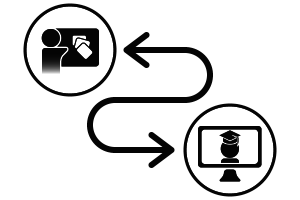Transitioning to an Online Class

Transitioning from teaching a face-to-face class to teaching an online course requires rethinking and reconfiguring materials. Lectures, activities, and assessments that worked for your face-to-face class will need to be tweaked or replaced because of the nature of the online environment. For example, online courses tend to be shorter (e.g., six or eight weeks) than face-to-face classes, which may impact the course’s overall structure, and participation requirements will likely be entirely different (e.g., posting to asynchronous discussion forums rather than attending class meetings). Even materials that exist in both formats will end up looking different; for example, you can lecture extemporaneously in a face-to-face class for an hour or more, but online lectures work better when they are scripted and recorded in 10- to 20-minute segments.
This article discusses some of the benefits of the online learning format and how you can structure your course materials to take advantage of those strengths.
Why Should You Transition Your Class?
Online classes have many advantages.
- Students can consume lecture content at their own pace, rewinding and rewatching videos as much as they need to understand the material.
- Students can work collaboratively through Web tools that facilitate collaboration and allow you to give feedback when it is most useful.
- Students spend time discussing and applying course content, which helps them learn it more deeply and retain it longer.
- Students can plan their study time around their busy schedules, creating a better balance between work and family obligations.
- Students who are shy might find it easier to participate in forums or chat rooms than in face-to-face discussions.
What Should You Know About the Online Classroom?
Online classes require you to spend your time differently and also use different skill sets to teach content. Although you will no longer have to plan and deliver all your lectures during the semester (phew!), you will still need to plan class sessions thoughtfully, which will include identifying learning objectives, planning activities, and thinking through logistics and timing.
As you begin to plan for your online class, ask yourself: What do I want my students to be able to do with the content I have provided in videos, readings, and other resources?
- Debate it?
- Analyze it?
- Evaluate it?
- Use it to solve problems?
- Extend it into new contexts?
- Apply it to the real world?
- Enlist it to create something new?
Once you’ve answered that question, you can begin to prepare appropriate activities.
Ideas for Online Activities
What sorts of activities should you assign in your online class? Activities can vary greatly depending on your discipline, course level, goals, and so on, but here are some ideas to get you thinking.
Routine problem solving: Take problems you might otherwise have assigned for homework and have students solve these problems in pairs or small groups using discussion boards or Web conferencing tools. Then choose groups at random to prepare a presentation of their solutions to the class via discussion board.
Complex problem solving: Assign complex problems that require students to distinguish between relevant and irrelevant information, search for additional information, generate and evaluate solutions, and so on.
Flawed solution: Present a flawed solution to a case or problem, and ask students to identify and explain what is wrong with it. Or ask students to present a solution with intentional errors for their classmates to debug.
Idea, importance, application, questions: Ask students to bring to the discussion boards (1) an idea or concept they learned from your lecture videos, (2) an explanation of its importance, (3) one way to apply it in the real world, and (4) questions they have. Use these items to spark further discussion.
Q and A: Ask students to prepare and submit questions about the material covered in lectures or readings, and then use a discussion board to address these questions and clarify areas of confusion in class.
Case studies: Have students read, analyze, and discuss case studies in groups. Groups can report their analyses and recommendations to the class through a discussion board.
Debates: Pose a controversial question and have students work in groups to conduct research, generate arguments for and against the issue, and formulate their own perspective.
Discussion: Assign substantive, open-ended questions about the reading or lecture material for students to discuss in groups, and then have them report back.
Peer instruction: Have students individually answer a set of questions and then compare their answers with a classmate and reconcile differences through discussion.
Concept mapping: Have students use a digital whiteboard from a Web tool to create a concept map that represents their understanding of a particular concept or set of ideas.
Student presentations: Have students present project proposals, evolving research, or finished projects for peer and instructor feedback.
Establishing a Routine
Generally speaking, it’s a good idea to develop a routine for online classes so that students know what’s expected of them. Here’s an example of one possible routine:
- Introduction: Introduce the material by providing a high-level overview of the relevant material at the beginning of the week.
- Response to student e-mails: Try to respond to student e-mails in a timely fashion (e.g., within 24 hours).
- Clarification: Create a mini-lecture to introduce materials and clarify common points of confusion.
- Assignments: Create clear instructions for assignments. Describe the task, explain how much time students will have to work, and clarify what they should complete. Provide grading rubrics.
- Feedback: Provide feedback in discussion boards and assignments.
- Preview: Set the stage for the next module.
After establishing a routine, you can then vary it to provide some novelty and keep things fresh.
Like most aspects of teaching, running an effective online course is an art. It will take time to develop the pedagogical approach that works for you, so be patient with yourself. Although the transition to an online classroom may seem daunting, careful planning will ease this change and ensure success for both you and your students. Take the time before your course starts to determine your goals, your course content, and the activities that will work best in your online course. Consider the structural changes and decisions you will need to make. Decide how you will deliver your course materials, familiarize yourself with the available Web tools, establish a weekly routine, and don’t be afraid to try something new. You can transition smoothly to teaching in the online environment. Preparation is your friend!


